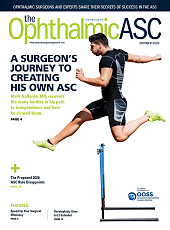For years, ophthalmologists have recommended Age-Related Eye Disease Study (AREDS) vitamins to patients with age-related macular degeneration (AMD), based on the landmark studies suggesting the supplements slow progression to late-stage forms of AMD. Earlier this year, an analysis of those studies, AREDS and AREDS2, found that antioxidants and vitamins slowed geographic atrophy (GA) progression toward the central macula in patients with advanced AMD. However, a new study using multimodal imaging refutes these claims. Researchers will present their findings at the 129th annual meeting of the American Academy of Ophthalmology, the AAO noted in a press release.
The original AREDS study, launched in 1992, and its successor AREDS2, begun in 2006, represented major breakthroughs in preventing advanced forms of AMD. They showed that vitamin supplementation could significantly slow progression to wet macular degeneration, the more treatable form of advanced disease, among high-risk patients.
However, the studies found no benefit for GA, the "dry" form of advanced AMD that accounts for roughly half of severe vision loss from the disease. Then in a recent reanalysis combining 2 of the AREDS studies, researchers led by Keenan and colleagues reported something unexpected: among patients who already had GA, AREDS vitamins appeared to slow the condition's progression toward the fovea—the critical area responsible for sharp, detailed vision—by 22 μm to 34 μm per year. That finding generated considerable interest in the retina community, but it also raised questions, given that the original studies had used color fundus photography, an older imaging technique, to measure disease progression.
To address these questions, Rishi P. Singh, MD, incoming chair of the Department of Ophthalmology at Mass Eye and Ear and Mass General Brigham, and colleagues reexamined data from OAKS and DERBY, 2 recent trials testing pegcetacoplan, one of 2 drugs now FDA-approved for GA. These studies included more than 1,200 untreated eyes and employed state-of-the-art imaging: fundus autofluorescence and optical coherence tomography (OCT). The modern techniques allow far more precise measurements of GA than were possible in the 1990s and 2000s. Critically, the newer imaging methods are now the standard accepted by regulatory agencies for evaluating treatments.
The researchers found no significant effect of AREDS or AREDS2 supplementation on overall GA growth. They also found no effect on progression toward the fovea—directly contradicting the Keenan analysis.
"We were quite surprised," Dr. Singh said. They believe the previously reported benefit may have been an artifact of the older measurement techniques, though differences in study populations and duration could also play a role.
An independent analysis of AREDS supplements using data from 2 other clinical trials, CHROMA and SPECTRI, came to the same conclusion. The finding takes on added significance now that 2 FDA-approved treatments—pegcetacoplan and avacincaptad pegol—have been shown to slow GA progression.
For the public, the researchers advise caution. "Until there's more data like from a prospective randomized clinical study, we don't know if antioxidants and macular pigments like lutein have beneficial effects on geographic atrophy," Dr. Singh said. RP








